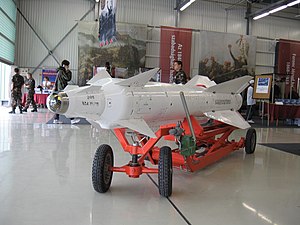Kh-29
| Kh-29 (NATO reporting name: AS-14 'Kedge') |
|
|---|---|

Kh-29L
|
|
| Type | air-to-surface missile |
| Place of origin | Soviet Union |
| Service history | |
| In service | 1980s-current |
| Used by | Warsaw Pact, China, India, Iraq |
| Wars |
Iran–Iraq War 2014 Libyan conflict Russian-led military intervention in Syria |
| Production history | |
| Designer | Matius Bisnovat Georgiy I. Khokhlov |
| Designed | 1975 |
| Manufacturer | Vympel / Tactical Missiles Corporation |
| Produced | 1980-current |
| Specifications | |
| Weight | Kh-29L :660 kg (1,460 lb) Kh-29T :685 kg (1,510 lb) Kh-29TE :690 kg (1,520 lb) |
| Length | Kh-29L/T :390 cm (12 ft 10 in) Kh-29TE :387.5 cm (12 ft 9 in) |
| Diameter | 38.0 cm (15.0 in) |
| Warhead | HE armour-piercing |
| Warhead weight | 320 kg (705 lb) |
|
Detonation
mechanism |
Impact |
|
|
|
| Engine | Fixed thrust solid fuel rocket |
| Wingspan | 110 cm (43 in) |
|
Operational
range |
Kh-29L :10 km (5.4 nmi) Kh-29T :12 km (6.5 nmi) Kh-29TE :30 km (16 nmi) |
| Speed |
1,470 km/h (910 mph) |
|
Guidance
system |
Kh-29L: semi-active laser guidance Kh-29T/TE : passive homing TV guidance Kh-29D : infrared homing guidance (IIR) Kh-29MP : active radar homing |
|
Launch
platform |
Kh-29L&T: MiG-27K, MiG-29M, |
1,470 km/h (910 mph)
Kh-29L&T: MiG-27K, MiG-29M,
Su-27UB, Su-30MK, Su-39
Kh-29L only: Su-25
Kh-29T only: Su-35
The Kh-29 (Russian: Х-29; NATO: AS-14 'Kedge'; GRAU: 9M721) is a Soviet air-to-surface missile with a range of 10–30 km. It has a large warhead of 320 kg, has a choice of laser, infrared, active radar or TV guidance, and is typically carried by tactical aircraft such as the Su-24, Su-30, MiG-29K as well as the "T/TM" models of the Su-25, giving that craft an expanded standoff capability.
The Kh-29 is intended for primary use against larger battlefield targets and infrastructure such as industrial buildings, depots and bridges, but can also be used against ships up to 10,000 tonnes, hardened aircraft shelters and concrete runways.
Design started in the late 1970s at the Molniya design bureau in Ukraine on what would be their only air-to-ground munition, but when they moved exclusively to space work Vympel took over development of the Kh-29. The first firing of the missile took place in 1976 and after extensive trials the Kh-29 was accepted into service in 1980.
The basic aerodynamic layout of the Kh-29 is similar to the Molniya R-60 (AA-8 'Aphid'), reflecting Molniya's heritage in air-to-air missiles. The laser guidance head came from the Kh-25 (AS-10 'Karen') and the TV guidance from the Kh-59 (AS-13 'Kingbolt'), mated to a large warhead.
It has been compared to the United States' AGM-65 Maverick, but the AGM-65 is a much smaller missile than the Kh-29, and weighs less than half as much.
The Kh-29 entered service with the Soviet Air Force in 1980, and has been widely exported since.
The Kh-29L were used by Sukhoi Su-34 and Su-24 aircraft in the 2015 Russian military intervention in the Syrian Civil War.
...
Wikipedia
